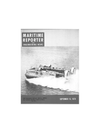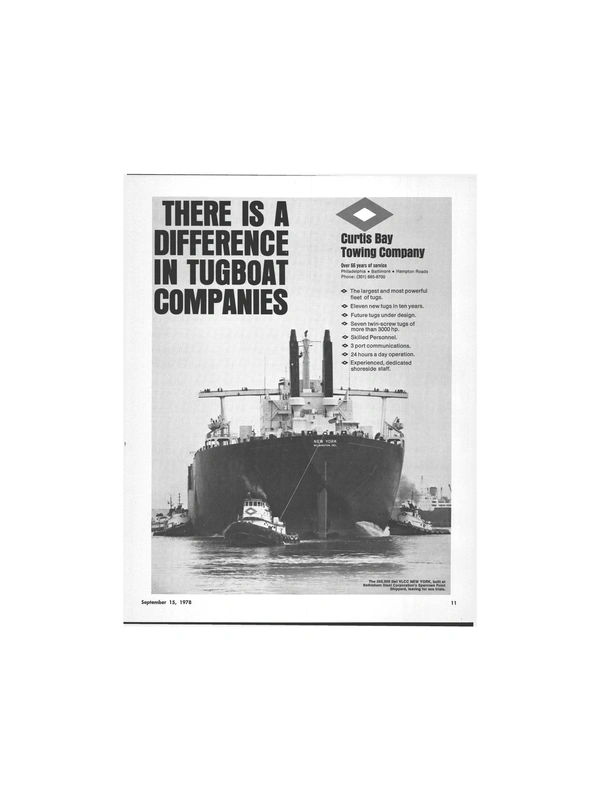
Newfoundland Headed For Major Economic Advances In 1980s
With oil and gas reserves equal to the North Sea, a commercial fishing industry expected to triple in size, huge mineral deposits, and extensive hydro-power potential, "the 1980s will be the decade that belongs to Newfoundland and Labrador," according to a new publication, "Newfoundland Opportunity." The 16-page color publication, issued by the provincial Department of Industrial Development, St. John's, Newfoundland, Canada, welcomes outside investors, saying: "What we need is investment capital, because with just 562,000 people in a province that covers 144,000 square miles, local financial resources are obviously limited." The new publication ticks off these resource-based opportunities : Offshore oil and gas reserves calculated at one-quarter of Canada's potential. Potential for a storage and transshipment terminal at Bell Island in a former iron mine that can hold up to 90 million barrels of oil at one-fifth the cost of conventional tank storage.
With the value of Newfoundland fish landings expected to triple by 1985 to $200 million, along with a fivefold increase in export value, investment opportunities are emerging for secondary processing operations, such as canning, breading, smoking and vacuum packaging.
Mining is already an $846 million industry in Newfoundland, but the surface has already been scratched. There are approximately 2,500 mineral deposits and occurrences, including copper, lead, gold, zinc, silver, gypsum, limestone, cadium, barium, silica, asbestos, pyrophyllite, iron, as well as stone, clay, sand, and gravel.
Hydro-power potential is immense, particularly in the Lower Churchhill River in Labrador, where over $78 million has already been spent toward a hydropower project that will add 1,800 megawatts and cost approximately $2.3 billion when completed.
Newfoundland is rich in forestry lands. Waiting for profitable development are 75 million acres of productive forest land, including enough timber for a sustainable annual cut of 2.6 million cords of softwood and 100,- 000 cords of hardwood. The forestry industry is already sizeable.
In 1978, Newfoundland newsprint exports are expected to be worth $158 million, and the industry as a whole has a $72-million annual payroll.
Investment opportunities await the secondary industry manufacturer.
Currently produced are a number of high technology products— f o o t w e a r , food products, cement, steel products, containers, paints, varnishes, wallboard, chemicals, and boats ranging from small craft to giant trawlers, and oil supply vessels.
For a copy of the new publication, write Dept. DCI-Newfoundland Opportunity, Suite 2100, 733 Third Avenue, New York, N.Y.
10017.
Read Newfoundland Headed For Major Economic Advances In 1980s in Pdf, Flash or Html5 edition of September 15, 1978 Maritime Reporter
Other stories from September 15, 1978 issue
Content
- Data Sheet Describes Shipboard Interior Fireproof Panels page: 4
- Bell Aerospace Delivers 160-Ton Air Cushion Landing Craft To Navy page: 6
- Avondale To Construct Two Multi-Product Ships For Ogden Marine page: 6
- Orion Gautreaux Named Zapata Vice President page: 6
- Eagle Dredging Awards $25-Million Contract To Avondale Shipyards, Inc. page: 8
- Newfoundland Headed For Major Economic Advances In 1980s page: 9
- ALRC Gets $13-Million Award To Supply Pumps For Boeing-Built Ships page: 10
- W.E. Christiansen Jr. Joins St. Louis Ship page: 10
- PSI Completes Total Package Concept With Todd 'Apache' Contract page: 12
- MarAd Study Examines Shipping Policy Options page: 14
- Three-Day Maritime Safety Meeting Set For Chicago October 2-4 page: 15
- J. Ray McDermott & Co., Inc. Delivers 126-Foot Tug To Louisiana Tugs Company page: 16
- First Crab Boat Built By Halter Marine, The 150-Foot Alaskan Enterprise, To Operate In Bering Sea For Francis Miller page: 16
- Boeing Awards Six Hydrofoil Contracts Totaling $4,360,000 page: 18
- Hongkong United Dockyards Ltd. (HUD) Forms New Subsidiary page: 18
- NKK Signs Agreement With Baker Marine Corp. page: 20
- Women Invade Engineers' Seagoing Dredge Fleet page: 20
- Technical Report On Mooring For LNG Ships Released By MarAd page: 22
- Port Electric Named Marine Distributor By Jeamar Winches Ltd. page: 22
- Perry Oceanographies Designs And Builds New Undersea Work System page: 23
- Samson And SMATCO Join To Expand Traction Winch Market page: 24
- Captain Tom Smith Forms CTS And Associates page: 24
- Charles Lehman Elected ACBL Vice President page: 24
- Swann Oil Relocates New York Office page: 24
- IMODCO Receives Third Contract From PEMEX In Two-Month Period page: 24
- James H. Sanborn Joins Interstate And Ocean Transport Company page: 26
- L. James Gardner Joins Bath Iron page: 29
- Castle & Cooke, Inc. Plans Purchase Of Seven Ships page: 29
- Nominations Are Open For Shepheard Award For Maritime Safety page: 30
- Human Element In Ship Operation Is Subject Of Maine Maritime Seminar page: 30
- Halter Marine Adds Tenth Shipyard page: 30
- Raymond Subsidiary Awarded $10-Million Contract In Venezuela page: 36
- Port Everglades Foreign Trade Zone Expansion Approved page: 36
- Canadian Shipbuilding Production Summary For First Six Months page: 36
- Marine Concrete Structures Delivers First 2 Platforms From New Dock Facility page: 38
- The 1,000-Foot M/V George A. Stinson Joins National Steel's Fleet Of Ore-Carrying Vessels page: 40
- Australian Designs Fast 1,600-Ton Containership With Crew Of Only Five page: 40
- SNAME Gulf Central Section Told How A Load Line Assignment Is Obtained page: 43
- Repairing Vessels Since 1834, Camden Ship Repair Company Starts $4-Million Expansion page: 44
- API President Suggests That Oil Firms Should Participate In Solving U.S. Energy Dilemma page: 44
- World And U.S. Bulk Shipping page: 46
- The Effect Of The 1978 IMCO Tanker Safety And Pollution Prevention Conference On Ship Design And Operation page: 49
- James Sweat Joins Matzer Associates page: 49
- Offshore Logistics, Inc. Announces Earnings For The Year Ended June 30 page: 49
- Maritime Transportation Research Board Names Five New Members page: 50
- Francis A. Martin And Ottaway, Inc. Name Norman Jensen Partner page: 50
- Francis W. Bauer Joins ORBA Corporation page: 51
- Jardine Plans To Restructure Oilfield Servicing—New Name Jardine Offshore Promet page: 52


